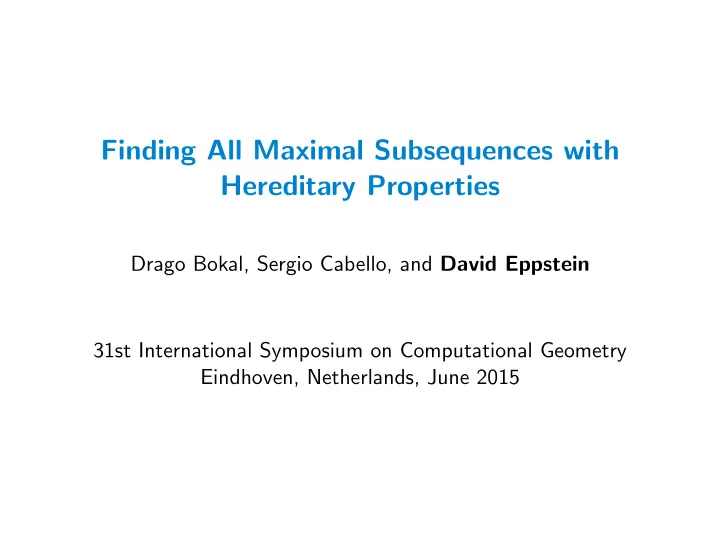

Finding All Maximal Subsequences with Hereditary Properties Drago Bokal, Sergio Cabello, and David Eppstein 31st International Symposium on Computational Geometry Eindhoven, Netherlands, June 2015
Trajectory analysis Data: sequence of points from one or more trajectories, in two or three dimensions, possibly also with timestamps Key problems include disambiguation of overlapping trajectories; clustering and finding representative paths for clusters; decomposition into pathlets; prediction and CC-BY-SA image ”my way” intentionality analysis by Michal Osmenda from Wikimedia commons
Windowed queries into trajectories Goal: Build a data structure that can quickly answer qualitative queries about contiguous subsequences of a trajectory Could be used for exploratory data analysis, or as a subroutine (e.g. to decompose paths into subsequences with uniform motion)
Previous work on windowed queries Bannister, Devanny, Bannister, Eppstein, Goodrich & Simons, DuBois & Smith, CCCG’14: SODA’13: Data = timestamped Data = two-party points (same as here) communication events Query = extreme Query = points of convex hull, graph-theoretic approximate nearest properties of the events neighbors, etc. within a time window We handle simpler queries (only Boolean answers) more quickly Our focus is less on query time and more on preprocessing
Our queries ◮ Does the subtrajectory have unit diameter? (Is the subject not moving much?) ◮ Does the convex hull of the subtrajectory have unit area? (Is the subject moving along an unobstructed path?) ◮ Is there a direction for which the subtrajectory is monotone? (Is subject moving in one direction but avoiding obstacles?) CC-BY-SA-image of St. Gotthard Pass by Srdjan Marincic on Wikimedia commons
The (trivial) data structure Query: does subsequence ( i , j ) have a (Boolean) property P ? We consider only hereditary properties: if a subsequence has P , so do all its sub-subsequences Store, for each i , the horizon j ∗ ( i ) s.t. ( i , j ∗ ) is maximal with P . To handle query ( i , j ), compare j with j ∗ ( i ) CC-BY image of Garrison of Sør-Varanger by Soldatnytt on Wikimedia commons But how do we find all of the horizons, efficiently?
Key ideas (1) a k a 2 R k − 1 a 1 a k R k R 1 a k +1 ( a 2 , a 3 ) R 2 R k +1 ( a 3 , a 4 ) R 3 a k +2 R k +2 a k +3 ◮ Greedily partition grid of potential queries ( i , j ) into frontier rectangles in which top right and bottom left corners are maximal yes-instances in their rows ◮ Partition is based on solving a collection of single-horizon search problems whose sizes sum to O ( n ) ◮ Use sequential or binary search for each single-horizon search
Key ideas (2) b b + w b c b + w b c b + w a a a Recursion m m m Recursion a + h a + h a + h Recursive divide and conquer into frontier subrectangles Split point = single horizon in median row Complication: subproblem size � = rectangle size So subproblems do not shrink quickly enough for divide and conquer to be efficient
Key ideas (3) The subtrajectories for a rectangular subproblem have three parts: ◮ Prefix of variable length given by row number in the rectangle ◮ Middle part of fixed length ◮ Suffix of variable length given by column number Replacing the middle part by a small sketch allows the subproblem sizes to shrink more quickly in the divide and conquer replace by sketch matrix of queries trajectory Example sketch for testing monotonicity: the range of angles for which the subtrajectory is monotonic
Results We can find all j -maximal subsequences of the trajectory that have property P . . . ◮ . . . in time O ( n ), when P is monotonicity ◮ . . . in time O ( n log n log log n ), when P is unit area ◮ . . . in time O ( n log 2 n ), when P is unit diameter Open: What other similar problems on trajectories fit into this framework? What about non-Boolean properties?
Recommend
More recommend